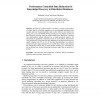Free Online Productivity Tools
i2Speak
i2Symbol
i2OCR
iTex2Img
iWeb2Print
iWeb2Shot
i2Type
iPdf2Split
iPdf2Merge
i2Bopomofo
i2Arabic
i2Style
i2Image
i2PDF
iLatex2Rtf
Sci2ools
PAKDD
2000
ACM
2000
ACM
Performance Controlled Data Reduction for Knowledge Discovery in Distributed Databases
The objective of data reduction is to obtain a compact representation of a large data set to facilitate repeated use of non-redundant information with complex and slow learning algorithms and to allow efficient data transfer and storage. For a user-controllable allowed accuracy loss we propose an effective data reduction procedure based on guided sampling for identifying a minimal size representative subset, followed by a model-sensitivity analysis for determining an appropriate compression level for each attribute. Experiments were performed on 3 large data sets and, depending on an allowed accuracy loss margin ranging from 1% to 5% of the ideal generalization, the achieved compression rates ranged between 95 and 12,500 times. These results indicate that transferring reduced data sets from multiple locations to a centralized site for an efficient and accurate knowledge discovery might often be possible in practice.
| Added | 25 Aug 2010 |
| Updated | 25 Aug 2010 |
| Type | Conference |
| Year | 2000 |
| Where | PAKDD |
| Authors | Slobodan Vucetic, Zoran Obradovic |
Comments (0)

